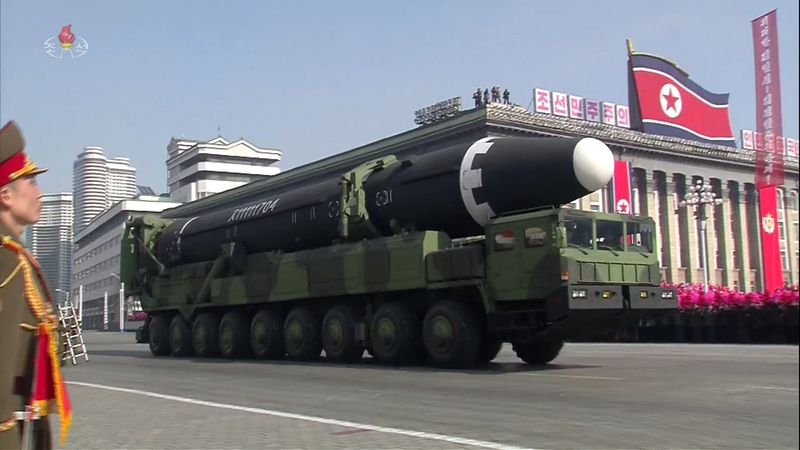 |
|
The North Korean Central News agency broadcast footage of a Hwasong-15 intercontinental ballistic movement being carried on a transporter erector launcher during a military parade celebrating the 70th anniversary of the founding of the North Korean People’s Army on Feb. 8. (Yonhap News)
|
The event was not broadcast live and was an hour shorter than the previous year’s celebration
On the morning of Feb. 8, North Korea held a military parade to celebrate the 70th anniversary of the foundation of the North Korean People’s Army (KPA). This was the first commemoration since North Korea decided last month to move the holiday from Apr. 25 to Feb. 8. Even so, the parade was smaller in scale than last year. The North Korean leadership appears to have been acting with prudent concern for what may happen after the Pyeongchang Winter Olympics. North Korea held the military parade at Kim Il Sung Square in Pyongyang in the morning and then broadcast a recording of the event on Korean Central Television at 5 pm. The actual parade appears to have begun at 11 am, South Korean military officials said. The North proceeded with the military parade in the teeth of criticism that flaunting military hardware the day before the opening ceremony of the Pyeongchang Winter Olympics (on Feb. 9) was a “military provocation.” During the military parade, North Korea showcased conventional weapons such as tanks, multiple rocket launchers and self-propelled artillery along with ICBMs such as the Hwasong-14 and Hwasong 15. But there did not seem to be any new strategic weapons. After inspecting the honor guard, Kim Jong-un, wearing a long coat and a black fedora, moved to the reviewing stand to view the military parade with his wife, Ri Sol-ju. This was the first military parade that Ri has been confirmed to have watched. “We must prevent the aggressors from mocking or violating the dignity and autonomy of our sacred fatherland in any way,” Kim said in a speech. A notable appearance was made at this event by newly appointed KPA General Political Bureau Director Kim Jong-gak, who sat at the reviewing stand to the right of Kim Jong-un. But Hwang Pyong-so – who previously held that post and was reportedly ousted not long before – was nowhere to be seen. Other prominent figures at the military parade were Kim Yong-nam, the president of the Presidium of the North Korean Supreme People's Assembly; Kim Yo-jong, first vice director of the central committee of the North Korean Workers’ Party (KWP); and Choe Hwi, chairman of the National Sports Guidance Committee, all members of the high-ranking delegation that is visiting Pyeongchang on Feb. 9. As North Korea had previously promised, the military parade was conducted with apparent concern for post-Olympic inter-Korean relations. The parade reportedly lasted about an hour and 30 or 40 minutes – an hour shorter than last year’s military parade, which lasted for two hours and 51 minutes, from 10:05 am to 12:56 pm. “The program was curtailed compared to last year,” a military official said. In addition, North Korea played a recording of the military parade in the afternoon instead of broadcasting it live, as it did with the military parade that was held at Kim Il Sung Square in Apr. 2017. “It’s very rare for North Korea not to broadcast a military parade live,” a senior military official said. Another departure from last year was that foreign journalists were not invited to this parade. Since this military parade was celebrating the KPA foundation day and last year’s military parade was marking the 105th anniversary of the birthday of Kim Il-sung on Apr. 15, a one-to-one comparison is not possible. Even so, this military foundation day marked the 70th anniversary of the KPA, which was established on Feb. 8, 1948. The downscaled event coincides with North Korea’s tradition of holding extravagant celebrations at intervals of ten years. Such behavior appears to exhibit restraint designed to prevent the controversy from spreading. Many analysts believe that North Korea kept the military parade low-key with post-Olympic developments in mind. “North Korea appears to have played down the military parade as a domestic event after concluding that there was no reason to rain on their neighbors’ parade. This means that they intend to use the Olympics as an opportunity for improving inter-Korean relations,” said Kim Dong-yub, a professor at the Kyungnam University Institute for Far Eastern Studies. By Park Byong-su, senior staff writer Please direct questions or comments to [english@hani.co.kr]






